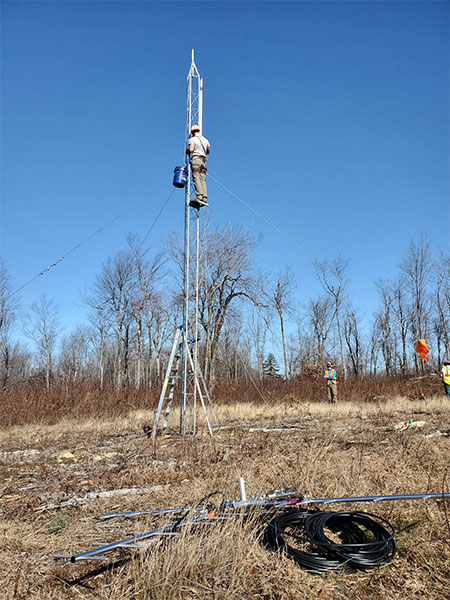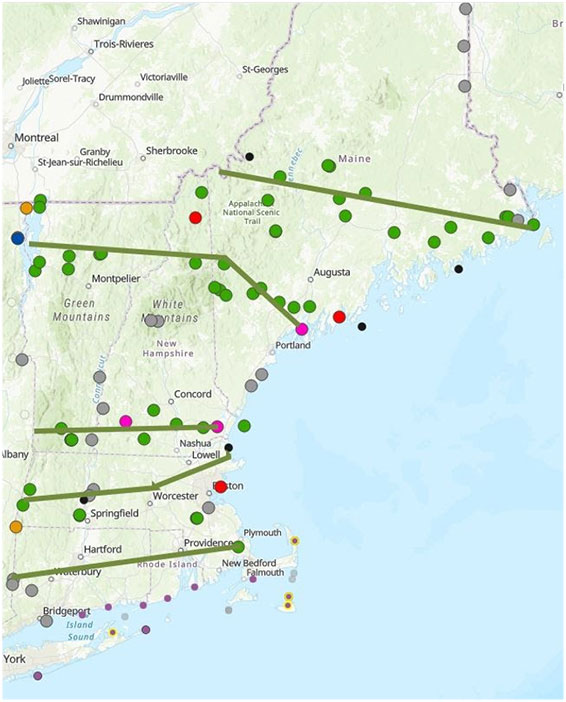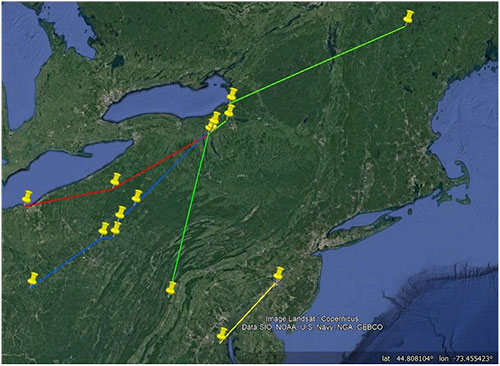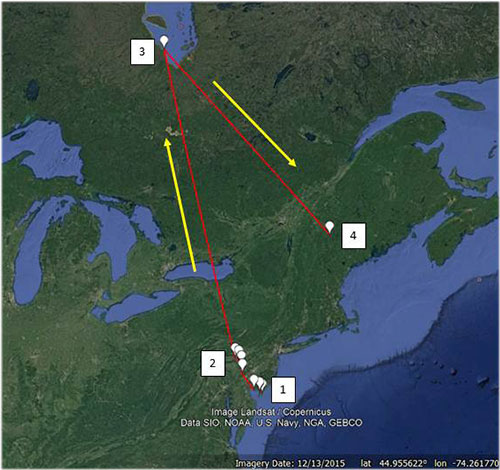Motus for New England Underway!

Article by Carol Foss
Photo: Installing the Motus tower at the Harris Center for Conservation Education in Hancock, NH on 11-6-2020. Photo by Marc Nutter.
We are delighted to report that the US Fish and Wildlife Service issued a $998,000 Competitive State Wildlife (C-SWG) grant, matched by $357,000 of private funds and in-kind services, which will provide for installation of 50 Motus receiving stations throughout New England over the next three years. C-SWG grants require multi-state partnerships, and NH Audubon played a lead role in preparing the grant proposal and in recruiting the NH Fish and Game Department as the lead agency and the Maine, Massachusetts, and Pennsylvania wildlife agencies as partner states, and the Carnegie Museum of Natural History (Carnegie Institute), Maine Audubon, Massachusetts Audubon, and the Willistown [PA] Conservation Trust as collaborating organizations.
The Motus Wildlife Tracking System is a global network of automated telemetry receiving stations coordinated by Birds Canada. Stations detect very high frequency (VHF) radio signals from tiny nanotags that all transmit on the same frequency (in unique patterns for each tag) and can be deployed on small birds, bats, and even large insects. This new technology makes it possible to identify migration routes, stopover areas, and wintering locations for small animals whose travels have been impossible to study at a landscape scale. What’s more, most stations will be connected to the cellular network and can upload this data directly to the Motus servers, making important migratory data available to both researchers and educators in near-real time.
The goal is to arrange the receiving stations in several “fence lines” across the region, designed to detect any tagged animals migrating through the region (Figure 1). While the majority of receiving stations will be installed in 2021, we anticipate getting three stations on line in 2020. We deeply appreciate the support of our partners at the Harris Center for Conservation Education, who are hosting the first receiving station to be installed as part of this project. Stations at Phillips Exeter Academy and Maine Audubon’s Hamilton Sanctuary are also scheduled for 2020. Project partners will spend the winter investigating other potential locations, making site selections, completing necessary administrative work to prepare for next year’s installations, and raising matching funds for the federal grant.
FIGURE 1 below shows potential locations for Motus receiving stations in New England. Red circles indicate existing stations. Pink circles indicate stations planned for installations in 2020. Green circles indicate possible sites yet to be investigated on the ground. Small circles indicate currently inactive, previously installed stations.

NH Audubon is working closely with the Willistown Conservation Trust to plan the locations and installations of the 50 regional stations, including 8-12 in New Hampshire. We are also raising $126,000 of matching funds for the federal grant through private grants and donations. All matching funds will be used to purchase the supplies and equipment to make this project a reality. Each station costs about $6,000 in supplies alone to construct, and we are looking to build a maintenance fund to ensure that we have the resources to keep these receiving stations supporting migratory research beyond the three year scope of this project. If you are interested in supporting the project financially at any level, or would like to volunteer your time in helping construct these stations, please contact Marc Nutter (mnutter@nhaudubon.org).
The grant also funds three associated research projects. The Carnegie Institute will be testing the detection ranges of various combinations of receivers and antennas in a variety of landscapes. Massachusetts Audubon and the Massachusetts Division of Fisheries and Wildlife will be collaborating on a study of American Kestrel movements and survival. NH Audubon will be testing detection ranges of new 0.15-gram nanotags and using them to study Monarch migration at the New Hampshire coast and in the Merrimack River Valley.
Motus technology has already been deployed in our Rusty Blackbird research with fascinating results (presented in a separate article). A receiving station in Dixville installed in 2019 located not only local Rusty Blackbirds but also detected passage of migrating Semipalmated Sandpipers tagged in Canada and Brazil, an American Woodcock on its migration (Figure 2 below), Red Knots tagged in South Carolina and New Jersey (Figure 3 below), a Whimbrel tagged on the shores of Hudson Bay, and a Willow Flycatcher tagged in Colombia. We look forward to learning about the travels of other migrants passing over New Hampshire and New England when the New England Motus network is up and running!
Figure 2 - American Woodcock

Figure 3 - Red Knot

- May 21-31, 2019, migration stopover, Cape May, NJ.
- June 1, 2019, passage through eastern Pennsylvania.
- June 2, 2019, west shore of James Bay, Ontario.
- August 9, 2019, passage over Dixville, NH!
To learn more about the New England Motus Project or how you can help, contact Carol Foss (cfoss@nhaudubon.org) or Marc Nutter (mnutter@nhaudubon.org).